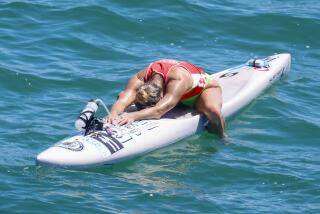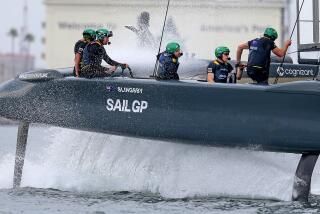Technology Sails Solidly to the Fore : Future Shock Is the Wave of Future for 12-Meter Racing
FREMANTLE, Australia — One boat or three? Aluminum or fiberglass? A rudder up front? Winged, torpedo or surfboard keels? A year’s testing and training in Hawaii or two years in Fremantle?
There are a lot of ways to pursue the America’s Cup. Which combination is best?
“Whichever one wins,” Dennis Conner said many months ago.
Some of the successes and failures can be measured after the challenger trial rounds, and Harold Cudmore, skipper of Britain’s ousted White Crusader, concluded: “The boats that have been conservative in their designs have not come through.”
For the semifinals starting Dec. 28, the field has been reduced to this mixed bag:
--From San Diego, Conner’s lead-bottomed, banana-shaped Stars & Stripes ‘87, truly a horse for the course, if the wind blows.
--From San Francisco, Tom Blackaller’s double-ruddered USA with the shark-shaped keel.
--From Auckland, New Zealand’s fiberglass enigma, KZ7.
--From Sete on the south coast of France, a more conventional and less adept French Kiss, whose name is more daring than its design.
Johan Valentijn, who designed the unsuccessful Eagle for the Newport Harbor Yacht Club, scoffs. “The only radical boat is Blackaller’s,” he says.
The others he dismisses as modest evolutions of Australia II, whose winged keel many thought had boosted sailing out of the dark ages of design.
KZ7 is a good boat that just happens to be built of fiberglass, and Conner simply built a heavy boat that sails well in strong winds, Valentijn said.
Unfortunately, Valentijn is in a slump and anything he has to say right now about 12-meter design may not be taken seriously. In 1983, he built Liberty, which lost the cup by 41 seconds, and this time, he created Eagle, which finished 10th by winning 10 and losing 24.
Blackaller, on the other hand, seems to be suddenly in demand, and he’s saying the same things.
“It looks like our technology is superior,” he said. “We took a big chance with this boat. (It’s) quite obviously the most different boat here, the most far-out stab at a high-tech solution to the America’s Cup racing problem, and it looks like we have solved the problem correctly.
“It isn’t just another winged keel boat. All the guys that have been yelling that they’ve been putting high tech into their efforts have been doing something else . . . copying (Australia II designer) Ben Lexcen and making the wings a little fatter. They’re all dragging wings around, and it looks like they’re gonna drag ‘em home for Christmas.”
Valentijn, preparing to fly home today for Christmas, said he could have built a radical boat, too.
“Every designer’s dream is to build a super boat. But a radical boat doesn’t get born overnight, and 99 out of 100 radical boats don’t go anywhere. Blackaller’s does, and I’ll give him good points for that.
“If you build a radical boat, you have to make sure you have a backup. If you’re going to build just one boat, you can’t take a chance.”
Valentijn’s Eagle was launched only last April and wasn’t tested either in Fremantle conditions or against competitive 12-meters until it got here in September.
“When I came here in October I realized I should have been here for the (12-meter) World championships (in February),” Valentijn said. “You have to see a boat sailing in it . . . how the wave conditions peculiar to Fremantle affect the boat.”
But September was too late for any serious rethinking. “Everything was just a little bit too late,” Valentijn lamented.
After the second round, when Eagle saw itself going down for the third time, it desperately clipped its wings and slapped a surfboard-shaped appendage on the bottom of the fin.
The change affected the boat’s performance dramatically. It went slower than ever, winning only 2 of 11 races in the third round.
Valentijn said: “When things don’t go right, everybody zeroes in on one problem. ‘We gotta change the keel! We gotta change the keel!’ ‘So, OK, I’ll change the keel, whatever you want.’
“Those things either go very good or very bad. It was very bad. The boat had less stability.”
To Valentijn, the keel was the problem, not the solution.
“The boat is a competitive boat,” he insisted. “Apart from the crazy keel, it’s in the ballgame. (With the original keel), we were right in fifth place against those other guys for a while.”
Blackaller was asked recently: “What does the front rudder do for you?”
“It got us in a protest once,” he replied.
That was when the British challenged the legality of replacing the damaged fin during the third round.
USA and New Zealand have something in common: Neither program existed a year and a half ago.
Their late starts might have been an advantage. There is one theory here that America II’s failure was in over-preparation. The New York Yacht Club-sponsored effort was first at every step but became locked into a design program early, then was stuck with it while rivals continued on an evolutionary climb.
When it was suggested to an America II crewman that all of the current 12-meters would be obsolete by the next defense in 1990, he said: “Ours was obsolete this year.”
Project manager Ron Young said that USA’s late start made it necessary to pass the syndicates that had started earlier. “We had to take a short cut, a technological breakthrough to leapfrog ahead,” he said.
The answer was R-1, R for revolutionary.
USA also followed Valentijn’s idea and built a conventional boat, Young said: “so we’d have something to sail if our other boat proved to be a cockamamie idea. As late as November (‘85), we were still looking at variations. This one wasn’t the craziest by far.”
Asked what had been, Young replied: “I can’t tell you. We might use it next time.”
In a normal sailboat, the keel serves the dual purpose of providing stability with its weight and lateral resistance and lift with its plane.
“We separated the two functions and optimized each,” Young said.
The biggest problem was how to steer a boat with two rudders.
“We did have two helmsmen (in mind) for a little while, but we never went down that road very far,” Young said. “It was such a departure from the way people had learned to sail.”
When R-1 arrived in Fremantle, Blackaller wasn’t sure what he had. It was difficult to steer and erratic, but day by day the USA crew got it tamed.
“This boat has a lot of potential still, and the more we get to sail it the better it seems to go,” Blackaller said.
“There was an awful lot written that it was a light-air boat. We never thought that, and then we steamrolled big Dennis (Conner) in 25 knots and that was the end of that theory.
“We thought the boat was very fast in 18 knots of true wind. It seemed like at 18 she was very, very fast. She actually feels a little better in a stronger wind . . . pretty good from 16 all the way to 30.
“Any of these efforts that are run by designers are doomed to failure, because the designers will never stop designing. They will never let the boat settle down. We had a lot of that in our program. It was a constant fight to figure out what the designers wanted to do, what was right and when it was wrong, because they’d come up with 10 ideas a week.
“We were kind of lucky because we didn’t have enough money to do everything they said. That actually saved (us). We had to pick out what was exactly right, and it looks like we hit it.
“Our boat’s the fastest boat out there right now.”
America’s Cup Notes
The defender trials race jury Tuesday disqualified Kookaburra II in a protest filed by Australia IV in Sunday’s race. The decision reduced K-II by three points to 34 in the standings after Series C and boosted A-IV to 47, only six behind Kookaburra III. The jury ruled that K-III, on port, tacked so close under A-IV’s lee bow that A-IV, on starboard, had to tack away to avoid a collision.


